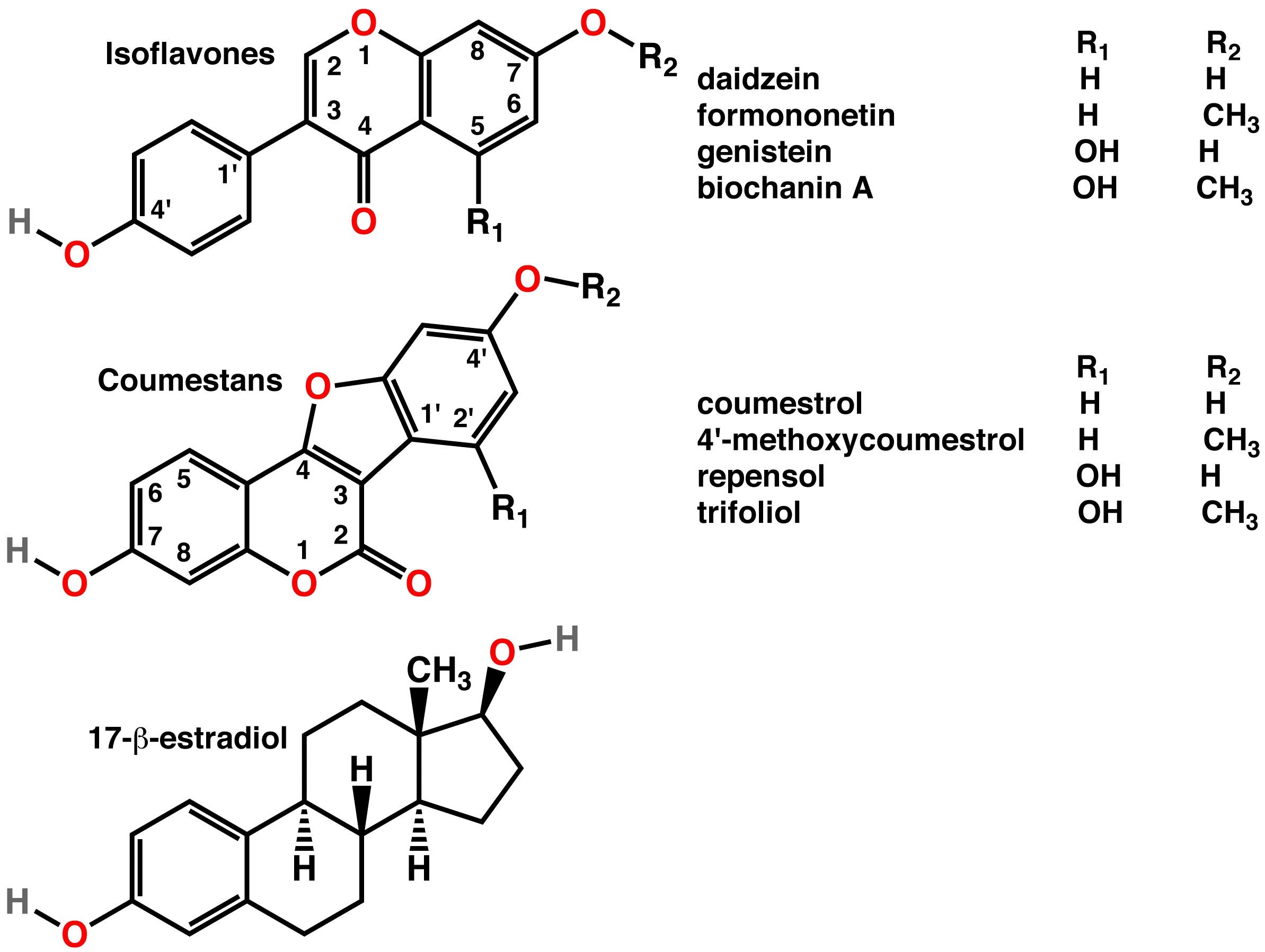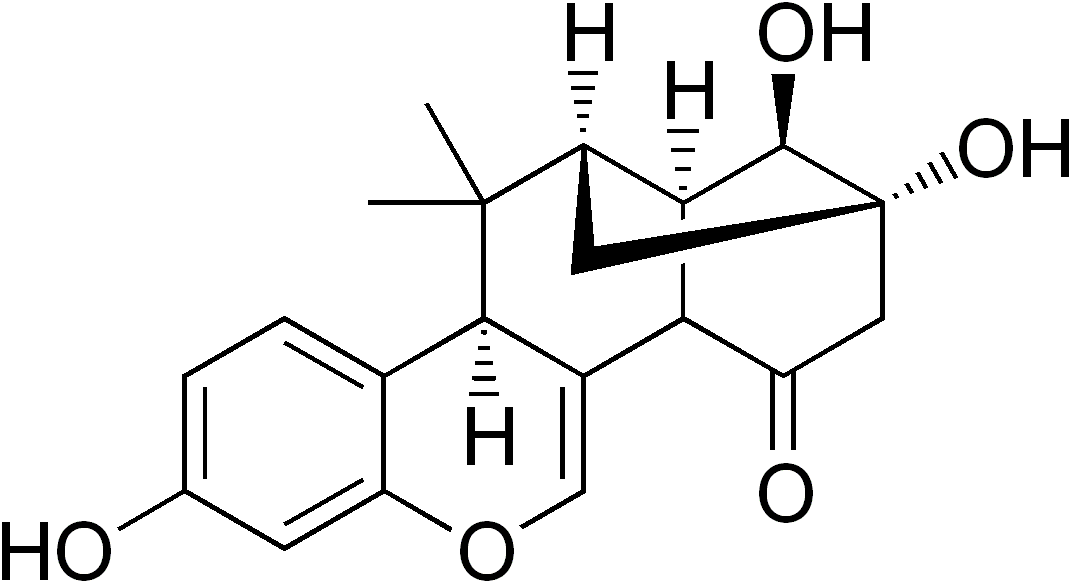|
Mirificin
Mirificin, also known as daidzein 8-C-(6-apiofuranosylglucoside), is an isoflavone that is found in ''Pueraria mirifica'' and ''Pueraria lobata''. It has estrogenic activity and hence is a phytoestrogen. See also * Daidzein * Deoxymiroestrol * Miroestrol * Puerarin Puerarin, one of several known isoflavones, is found in a number of plants and herbs, such as the root of '' Pueraria'' (''Radix puerariae'') notably of the kudzu plant. Puerarin is the 8-''C''-glucoside A glucoside is a glycoside that is der ...3'-Methoxymirificin References Flavone glycosides Isoflavones Phytoestrogens {{organic-compound-stub ... [...More Info...] [...Related Items...] OR: [Wikipedia] [Google] [Baidu] |
Pueraria Mirifica
''Pueraria mirifica'', also known as กวาวเครือ Kwao Krua (among other names), is a plant found in northern and north eastern Thailand and Myanmar. In Thailand, the plant is known as “Kwao Krua Kao”, the 'Kao' meaning white which distinguishes ''Pueraria mirifica'' from other plants with tuberous roots also sharing the 'Kwao Krua' designation such as '' Butea superba'', commonly called Kwao Krua Deng (Red) and the 'black' and 'dull grey' Kwao Krua plants. The species was definitively identified as ''Pueraria mirifica'' in 1952. Dried and powdered, the tuberous root of ''Pueraria mirifica'' has a history of domestic consumption in Thailand in traditional folk medicine as a rejuvenating herb to promote youthfulness in both women and men and is used widely within the now government-regulated practice of traditional Thai medicine. History Evidence of the use of ''Pueraria mirifica'' can be definitively identified as early as the 13th Century AD. The ancient ... [...More Info...] [...Related Items...] OR: [Wikipedia] [Google] [Baidu] |
Isoflavone
Isoflavones are substituted derivatives of isoflavone, a type of naturally occurring isoflavonoids, many of which act as phytoestrogens in mammals. Isoflavones are produced almost exclusively by the members of the bean family, Fabaceae (Leguminosae). Although isoflavones and closely related phytoestrogens are sold as dietary supplements, there is little scientific evidence for either the safety of long-term supplementation or of health benefits from these compounds. Some studies have identified potential risks from high intake of isoflavones, such as in women with a history of breast cancer, but this concern has not been substantiated with high-quality clinical research. Organic chemistry and biosynthesis Isoflavone is an isomer of flavone, which is chromone substituted with a phenyl group in the 2-position. In isoflavone, the phenyl group is in the 4-position. Isoflavone is of liminted interest per se, but substituted derivatives are of nutritional interest. Substituted deriv ... [...More Info...] [...Related Items...] OR: [Wikipedia] [Google] [Baidu] |
Pueraria Lobata
''Pueraria montana'' var. ''lobata'', the East Asian arrowroot, or kudzu vine, is a perennial plant in the family Fabaceae. Names It is called ''gé'' () in Chinese, ''kuzu'' () in Japanese, and ''chik'' () or ''gal'' (갈; 葛) in Korean. Distribution The plant is native to East Asia (China, Taiwan, Japan, Korea), the Russian Far East, Southeast Asia (Indonesia, Malaysia, the Philippines, Thailand and Vietnam), and the Pacific (New Caledonia, Papua New Guinea, Solomon Islands, and Vanuatu). Use The starch powder made from the East Asian arrowroot is called kudzu powder. Kudzu powder is used to make arrowroot tea in traditional medicines of China, Japan and Korea (in Korea the root unprepared is also used). File:Chik 2.jpg, East Asian arrowroot. File:Chikcha.jpg, Arrowroot tea. File:140614 Yagyu Iris Garden Nara Japan07s.jpg, Kuzumochi is a Japanese term referring either to cakes made of () or cakes made from Lactobacillales-fermented wheat starch (), a spe ... [...More Info...] [...Related Items...] OR: [Wikipedia] [Google] [Baidu] |
Estrogen
Estrogen or oestrogen is a category of sex hormone responsible for the development and regulation of the female reproductive system and secondary sex characteristics. There are three major endogenous estrogens that have estrogenic hormonal activity: estrone (E1), estradiol (E2), and estriol (E3). Estradiol, an estrane, is the most potent and prevalent. Another estrogen called estetrol (E4) is produced only during pregnancy. Estrogens are synthesized in all vertebrates and some insects. Their presence in both vertebrates and insects suggests that estrogenic sex hormones have an ancient evolutionary history. Quantitatively, estrogens circulate at lower levels than androgens in both men and women. While estrogen levels are significantly lower in males than in females, estrogens nevertheless have important physiological roles in males. Like all steroid hormones, estrogens readily diffuse across the cell membrane. Once inside the cell, they bind to and activate estrogen receptors (E ... [...More Info...] [...Related Items...] OR: [Wikipedia] [Google] [Baidu] |
Phytoestrogen
A phytoestrogen is a plant-derived xenoestrogen (see estrogen) not generated within the endocrine system, but consumed by eating plants or manufactured foods. Also called a "dietary estrogen", it is a diverse group of naturally occurring nonsteroidal plant compounds that, because of its structural similarity with estradiol (17-β-estradiol), have the ability to cause estrogenic or antiestrogenic effects. Phytoestrogens are not essential nutrients because their absence from the diet does not cause a disease, nor are they known to participate in any normal biological function. Common foods containing phytoestrogens are soy protein, beans, oats, barley, rice, coffee, apples, carrots (see Food Sources section below for bigger list). Its name comes from the Greek ''phyto'' ("plant") and ''estrogen'', the hormone which gives fertility to female mammals. The word "estrus" - Greek οίστρος - means "sexual desire", and "gene" - Greek γόνο - is "to generate". It has been hypothe ... [...More Info...] [...Related Items...] OR: [Wikipedia] [Google] [Baidu] |
Daidzein
Daidzein (7-hydroxy-3-(4-hydroxyphenyl)-4H-chromen-4-one) is a naturally occurring compound found exclusively in soybeans and other legumes and structurally belongs to a class of compounds known as isoflavones. Daidzein and other isoflavones are produced in plants through the phenylpropanoid pathway of secondary metabolism and are used as signal carriers, and defense responses to pathogenic attacks. In humans, recent research has shown the viability of using daidzein in medicine for menopausal relief, osteoporosis, blood cholesterol, and lowering the risk of some hormone-related cancers, and heart disease. Despite the known health benefits, the use of both puerarin and daidzein is limited by their poor bioavailability and low water solubility. Natural occurrence Daidzein and other isoflavone compounds, such as genistein, are present in a number of plants and herbs like kwao krua (''Pueraria mirifica'') and kudzu. It can also be found in ''Maackia amurensis'' cell cultures. Daid ... [...More Info...] [...Related Items...] OR: [Wikipedia] [Google] [Baidu] |
Deoxymiroestrol
Miroestrol is a phytoestrogen, a plant-derived chemical that mimics the biological activity of the hormone estrogen. Miroestrol was first reportedly isolated from the Thai herb ''Pueraria mirifica'' in 1960 and thought to be responsible for the supposed rejuvenating properties of the plant. However, more recent studies have suggested that the active ingredient may actually be the closely related chemical compound deoxymiroestrol (shown below), and the reported presence of miroestrol may only have been an artifact of the isolation procedure. When deoxymiroestrol is exposed to the oxygen in air, it is converted to miroestrol. A comparative study of the estrogenic properties of phytoestrogens found that both deoxymiroestrol and miroestrol were comparable in activity ''in vitro'' to other known phytoestrogens such as coumestrol as 17β-oestradiol agonists. Because of their estrogenic activities, miroestrol, deoxymiroestrol, and other related compounds have been the targets of s ... [...More Info...] [...Related Items...] OR: [Wikipedia] [Google] [Baidu] |
Miroestrol
Miroestrol is a phytoestrogen, a plant-derived chemical that mimics the biological activity of the hormone estrogen. Miroestrol was first reportedly isolated from the Thai herb ''Pueraria mirifica'' in 1960 and thought to be responsible for the supposed rejuvenating properties of the plant. However, more recent studies have suggested that the active ingredient may actually be the closely related chemical compound deoxymiroestrol (shown below), and the reported presence of miroestrol may only have been an artifact of the isolation procedure. When deoxymiroestrol is exposed to the oxygen in air, it is converted to miroestrol. A comparative study of the estrogenic properties of phytoestrogens found that both deoxymiroestrol and miroestrol were comparable in activity ''in vitro'' to other known phytoestrogens such as coumestrol as 17β-oestradiol agonists. Because of their estrogenic activities, miroestrol, deoxymiroestrol, and other related compounds have been the targets of s ... [...More Info...] [...Related Items...] OR: [Wikipedia] [Google] [Baidu] |
Puerarin
Puerarin, one of several known isoflavones, is found in a number of plants and herbs, such as the root of '' Pueraria'' (''Radix puerariae'') notably of the kudzu plant. Puerarin is the 8-''C''-glucoside A glucoside is a glycoside that is derived from glucose. Glucosides are common in plants, but rare in animals. Glucose is produced when a glucoside is hydrolysed by purely chemical means, or decomposed by fermentation or enzymes. The name was ... of daidzein. List of plants that contain the chemical *'' Pueraria lobata'' * '' Pueraria phaseoloides'' Notes and references Isoflavone glucosides Phenol glycosides {{Aromatic-stub ... [...More Info...] [...Related Items...] OR: [Wikipedia] [Google] [Baidu] |
Flavone Glycosides
Flavone is an organic compound with the formula . A white solid, flavone is a derivative of chromone with a phenyl (Ph) substituent adjacent to the ether group. The compound is of little direct practical importance, but susbstituted derivatives, the flavones and flavonoids are a large class of nutritionally important natural products. Flavone can be prepared in the laboratory by cyclization of 2-hydroxacetophenone. Isomeric with flavone is isoflavone Isoflavones are substituted derivatives of isoflavone, a type of naturally occurring isoflavonoids, many of which act as phytoestrogens in mammals. Isoflavones are produced almost exclusively by the members of the bean family, Fabaceae (Leguminosae) ..., where the phenyl group is adjacent to the ketone. References {{Flavones ... [...More Info...] [...Related Items...] OR: [Wikipedia] [Google] [Baidu] |
Isoflavones
Isoflavones are substituted derivatives of isoflavone, a type of naturally occurring isoflavonoids, many of which act as phytoestrogens in mammals. Isoflavones are produced almost exclusively by the members of the bean family, Fabaceae (Leguminosae). Although isoflavones and closely related phytoestrogens are sold as dietary supplements, there is little scientific evidence for either the safety of long-term supplementation or of health benefits from these compounds. Some studies have identified potential risks from high intake of isoflavones, such as in women with a history of breast cancer, but this concern has not been substantiated with high-quality clinical research. Organic chemistry and biosynthesis Isoflavone is an isomer of flavone, which is chromone substituted with a phenyl group in the 2-position. In isoflavone, the phenyl group is in the 4-position. Isoflavone is of liminted interest per se, but substituted derivatives are of nutritional interest. Substituted derivativ ... [...More Info...] [...Related Items...] OR: [Wikipedia] [Google] [Baidu] |



